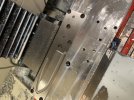The_Iron_Joe
Knifemaker, Jeweller. Custom Books Open!
- Joined
- May 3, 2012
- Messages
- 1,091
Like the title says... I wanted to try milling my blades AFTER heat treatment in order to avoid any warping issues encountered with how thin the blades get, but I am encountering a LOT of stress while machining the blade. While I can gradually machine both sides of a blade to try to avoid warp, this really isn't an efficient use of time, and has actually led to breakage of a support structure used to prevent vibration, which is just a flat portion of steel left outside the blade profile, on the side of what would later be the cutting edge. The stock becomes very thin on the finishing passes, and the internal stresses are enough to cause the blade to fracture, whereas there should be no cause for a break if the steel wasn't experiencing any stress.
I am very certain that I am not heating up the steel while I am milling it down, as I am using flood coolant constantly during the operations, and the stock material never gets warm to the touch. Additionally, I've milled plenty of annealed S35VN without any warping issues on the mill table whatsoever.
I have a feeling that I need to normalize the 20CV stock before I do the rest of my heat treatment, but I'm not exactly sure how I should go about doing that, and any other steps I should take. Ideally, the blades would then not warp while being milled after being hardened and tempered. Or am I missing something else?
I am very certain that I am not heating up the steel while I am milling it down, as I am using flood coolant constantly during the operations, and the stock material never gets warm to the touch. Additionally, I've milled plenty of annealed S35VN without any warping issues on the mill table whatsoever.
I have a feeling that I need to normalize the 20CV stock before I do the rest of my heat treatment, but I'm not exactly sure how I should go about doing that, and any other steps I should take. Ideally, the blades would then not warp while being milled after being hardened and tempered. Or am I missing something else?




